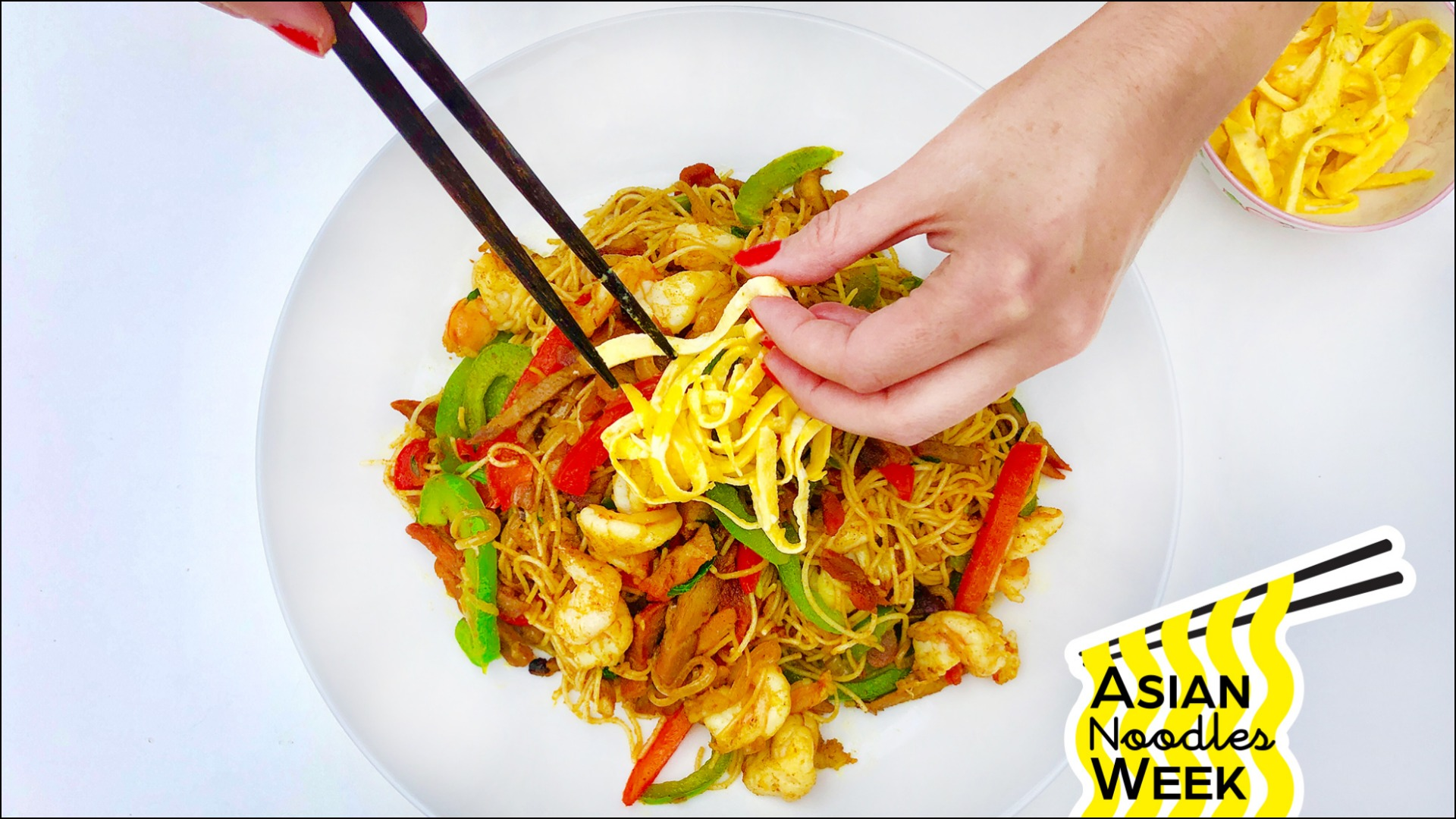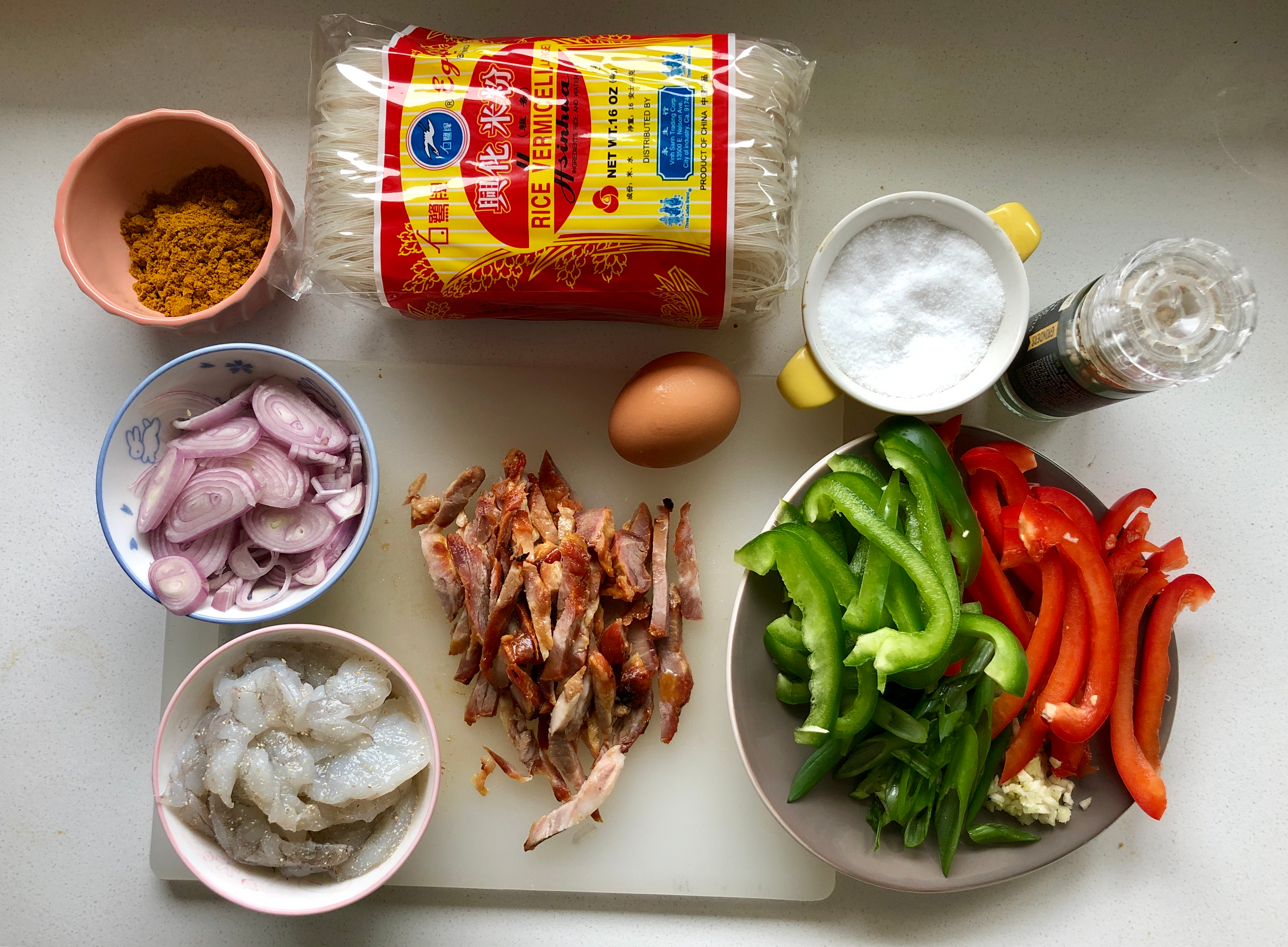Chef Curry: How To Make Singapore Noodles
Welcome to The Takeout's Asian Noodles Week, a tribute to the O.G. pasta bowl.
I don't remember seeing Singapore noodles featured in Crazy Rich Asians, a film that compelled food lovers to look up airfares to Singapore. But that's because this stir-fried noodle dish is a Hong Kong invention. It doesn't make it any less delicious, though.
Take your standard chow mein with shrimp and barbecued "char siu" pork, and substitute the thicker, chewier noodles for angel hair-like rice vermicelli. Then add in curry powder, bell peppers, and thin egg ribbons. This variation on stir-fry noodles is one of the most popular dishes you'll find in Hong Kong greasy spoons, or anywhere in the world with a Cantonese diaspora. And it's a dish that's sadly not ordered enough stateside.
I've picked up a few pointers from my Hong Kong-born in-laws. First, concerning the vermicelli, you'll want to boil the dried noodles first, but avoid overcooking them. One idea my in-laws passed along was to cook the vermicelli to about 75% (there's no way to gauge accurately, you're just looking for some firmness in the center), take out of the water, toss with vegetable oil, and cover with a towel. This way, it avoids clumping, and the residual heat will finish the noodles' cooking. You'll want to fight the urge to rinse the noodles in a colander.
The second thing is the addition of curry powder. (Spice Island will work just fine.) If you just sprinkle curry powder straight onto the noodle, it'll be harder to coat evenly throughout the dish, and worse yet, it may taste gritty. The solution is to heat up vegetable oil under a low heat, and add the curry powder to let the aromas bloom. After stirring together, you'll pour this oil over the noodles in your cooking vessel. This way, the curry flavor will be spread evenly.
Char siu can be easily found in any city with a Chinese population—just look for a place that does Cantonese-style barbecue. I know not everyone is so lucky, which is why you can also make your own. If this seems a bit labor-intensive to you (and the hardest part is tracking down the ingredients), then I'd suggest tossing thinly sliced pork belly with salt, white pepper, and a pinch of sugar before stir-frying. It'll work in a pinch.

Singapore Noodles
Serves 4
- 1 brick (8 oz.) rice vermicelli noodles, dried
- 1 Tbsp. mild or medium curry powder
- 2 Tbsp. neutral oil, like canola
- 2 scallions, thinly sliced
- 1/2 red bell pepper, julienned
- 1/2 green bell pepper, julienned
- 1 cup char siu, julienned (or sliced pork belly seasoned with salt, white pepper, sugar)
- 10-12 deveined shrimp, sliced lengthwise, seasoned with salt and white pepper
- 1 shallot, thinly sliced
- 1 garlic clove, minced
- 2 eggs
- Kosher salt and white pepper
- MSG powder (optional)
In a wok or deep 12-inch skillet, bring enough water to a boil to submerge your noodles. Add noodles, stir to gently separate and cook for two minutes. Turn off the heat. Let the noodles sit in the hot water until softened and white, but still al dente, about another two minutes. Drain noodles and toss in a bowl with a bit of neutral oil to avoid clumping—do not rinse noodles. Cover the bowl with a clean kitchen towel and let the noodles steam. Rinse your wok and set back on the stove.
Heat one tablespoon oil in your wok over medium-high heat. Add shallots and bell peppers, stir frying until just tender. Remove to a large bowl. Add the garlic and scallions and briefly stir-fry, until fragrant (about 30 seconds to a minute). Add shrimp and char siu, and stir fry until pork and shrimp are lightly cooked. (Note that char siu is already cooked, so you're just heating it up. If cooking pork belly, you'll want to add to wok first to cook through, before the shrimp.) Remove to the bowl with the other ingredients, and turn off the heat while you prepare the egg crepe and curry oil.
Beat two eggs with a pinch of salt in a bowl. Heat a bit of oil in a non-stick skillet, coating the bottom. When hot, add the eggs, swirling to coat the bottom of the pan. Tilt the pan to let uncooked egg flow to the edges. If you're feeling brave and the egg crepe seems firm and flexible, use your chopsticks and a spatula to flip it over to cook the other side for one minute. Otherwise, cover the pan and turn the heat off. The residual heat will finish cooking the raw egg on top of the crepe in 2-3 minutes.
When firm, slide the egg crepe onto a cutting board to cool, then gently slice into thin ribbons. Reserve for garnishing.

Separately in a small saucepan, heat two tablespoons of oil over medium-high heat, then add your curry powder and a teaspoon of kosher salt. Stir to incorporate and turn off the oil mixture. Back to your wok: Turn heat to medium-high, and stir-fry ingredients and noodles. Pour oil mixture over the noodles, and, using chopsticks or tongs, toss the noodles, proteins, and vegetables until evenly coated with the yellow curry oil. The dish will not look oily, but the noodles should be a uniform mustard-yellow hue. Taste the noodles for salt—the curry should not taste flat or bland. If it does, add more salt and toss to coat. Add MSG if desired—it'll make it more delicious. Garnish with egg crepe ribbons on top.

